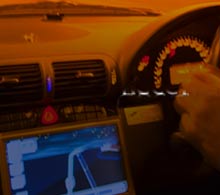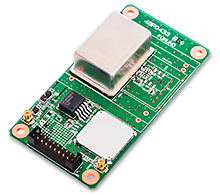Articles for ITS market Connected car and road-to-vehicle communication automatic operation
Test driving a Nissan automated driving car. An important issue for automated vehicles is the Vehicle to Infrastructure (V2I) integration.
 Based on the Skyline Hybrid, Nissan's latest automated driving test vehicle.
Based on the Skyline Hybrid, Nissan's latest automated driving test vehicle.
 At the 45th Tokyo Motor Show held at the end of October 2017, ETC 2.0 was promoted.
At the 45th Tokyo Motor Show held at the end of October 2017, ETC 2.0 was promoted.
I tried Nissan's latest version automated driving car in Odaiba, Japan area where the 45th Tokyo Motor Show (open to the public from October 27th - November 5th, 2017) had been held and just finished.
I had previously tried Nissan's automated driving vehicle on normal roads in the Odaiba area two years ago. This time it was a demonstration using a more complicated driving situation, such as automatic lane change on the capital express ways. I exchanged opinions on "ITS and big data" with the director in charge of Nissan advanced automated driving development during the test drive.
The director considers "Infrastructure” (V2I Communication: Vehicle to Infrastructure) as the most important issue for the practical use of advanced automated driving". Currently a typical example of road-vehicle communication is ETC (automatic toll collection system). This communication is done using the DSRC (Dedicated Short Range Communication) 5.8 GHz band. I have mentioned in a previous article that ETC 2.0 has better service than the earlier, normal ETC from 2015. The ETC 2.0 was also promoted at the 45th Tokyo Motor Show. However regarding road-to-vehicle communication, Nissan mentioned "further strengthening is necessary" and it does not include ETC 2.0.
"The importance of connected car" is a common recognition among those related to the automated driving car companies
 Six laser scanners (riders) in total were mounted on experimental vehicles.
Six laser scanners (riders) in total were mounted on experimental vehicles.
 The driving demonstration of the latest Nissan automated car on the capital express way.
The driving demonstration of the latest Nissan automated car on the capital express way.
For automated car operations the most important thing is "safety". This “safety” requires a safer driving level than human drivers can achieve with the goal being zero accidents or "ultimate safety". Actually people understand zero accidents may be impossible, but still seek a perfect automated driving experience.
In order to guarantee safety during automated driving, many kinds of sensors are mounted on the automated driving vehicle. For example in the case of the Nissan's automated driving car that I tested this time, it has a camera, a laser scanner (rider), a millimeter wave radar in 77 GHz band for long distance, a 24 GHz band for medium distance, and an ultrasonic sensor (sonar) for short distance.
However the distance that can be sensed is a few hundred meters in the front direction of the vehicle with a smaller sensed distance behind the vehicle. In the future attempts to improve the sensor's performance and increase the distance that can be sensed together are not likely to be accomplished.
This policy is not only anticipated by Nissan, but also by other Japanese companies such as Toyota and western companies like Daimler and GM. Information sensed ahead by hundreds of meters will be a possible technical limitation of the "Connected Car".
Information on the surrounding vehicles is not dependent on the V2V (vehicle to vehicle) communication but instead on the V2I (vehicle to infrastructure) communication.
A connected car is a system in which data is exchanged between the car and the outside infrastructure using communication from the car to the cloud, or from the cloud to the car.
In the automated driving system it transmits information such as weather, accident, construction, congestion, etc. to vehicle end, allowing the automated driving vehicle to look ahead at the road situation. This kind of utilization of big data method is already being used by ETC 2.0. It is called a “prediction of running”.
Meanwhile during the test drive in Nissan's automated driving vehicle I felt anxiety about sensing a car approaching diagonally from the rear when joining the main line after passing tollgate of the capital express way. If there is a concrete wall or pole between the main line, near the confluence point, the sensing of the vehicle may not read the exact position of the rear vehicle. To prevent this risk the live information confirms the positional relationship with the car near the vehicle using DSRC however 700 MHz bandwidth is needed.
Some people may think only data exchanging of V2V (vehicle to vehicle) is needed, but actually V2I (vehicle to infrastructure) communication is also required. Obviously V2I is slower than V2V on the data analysis and data transmission, but it is expected that some of these technical issues will be solved by the next generation communication method called 5G which will begin to spread in early 2020s.
In summary what I felt thorough the driving demonstration of the automated driving car is that there are still many issues to resolve before the automated driving level 3 or level 4 with zero accidents can be achieved.
Writer introduction

Mr. Kenji Momota Automotive journalist
His major is the world automotive industry and he is also familiar with the energy industry, IT and the aging society problem as the related fields. He acts around the world based in Japan and USA and writes for the general magazines, the technology journals and the automotive related media etc.
He is also commentator of motor race and world's motor show on TV program based on his career of the driver of Indy Racing League and NASCAR. In recent years, he has been covering about a paradigm shift from developed countries to developing countries, the motorized vehicle like EV and the telematics.
FURUNO ITS Journal
Click here for the latest articles after 2022 (in Japanese)2022
- The "realistic" self-driving roadmap shown by the Japanese government and a hands-on report on the latest Subaru EyeSight X
- Will FCVs (Fuel Cell Vehicles) Become Popular? ~New Movement in Toyota and Honda~
- The 'Complete' online sales of new cars start in Japan. Will this new way of buying cars take root?
- Many Firsts! On-Site Report from Tokyo Auto Salon 2022 - The author, who knows what goes on behind the scenes, looks back on 40 years of history. -
2021
- "Moving toward zero traffic fatalities for four-wheeled and two-wheeled vehicles globally in 2050" ~Experience on Honda's latest safety technologies~
- Tsuneishi Shipbuilding's building and DX, an exclusive visit to the main factory
- Japan's Smart City: New Moves toward Practical Use
- When will self-driving buses (service cars) be put to "full-scale" practical use?
- Utilization vehicle data during disasters
- Toyota-led Connected Technology to Transform Commercial Vehicle Business -From light trucks to large trucks and buses-
- Toyota enters the connected car "Personalization" business
- Japanese automakers' carbon-neutral strategies swept up in ESG investment
- Drive experience of the latest autonomous vehicle models and advanced driving support systems
- Will carbon neutrality accelerate the trend to strengthen LCA (Life Cycle Assessment)?
- Semiconductor shortage exposes realities of the automotive industry
- Online Autonomous Driving Contest Enhancing development of Human Resources
2020
- What happens to CASE when gas cars are banned in Japan?
- When will Flying Cars be launched?
- Expectation vs. reality:Autonomous Driving in Japan
- V2X, Becoming increasingly important in autonomous driving
- Technology of Subaru “EyeSight X”
- Lifestyle-oriented French cars gain popularity in Japan
- Human-oriented smart cities are wanted
- MaaS and CASE, how would automotive industry change after COVID-19?
- The beginning of virtualization era, triggered by COVID-19
- Trend of EV shift and consumer demands
- TOYOTA Press conference about ADAS - Releasing algorithm for "sudden acceleration suppression during attempted sudden acceleration" free of charge -
- The Japanese automotive industry in 2020 - 3 turning points -
- "Using a smartphone while driving" and "Level 3 automated driving"
2019
- Motor show business model is at a turning point - Tokyo Motor Show Report -
- Commercialization and monetization of MaaS - ITS World Congress Singapore Report -
- Android Automotive pays attention to V2X - Report from the Frankfurt Motor Show 2019 in Germany -
- Automobile Distribution Revolution and DCM (Data Communication Module)
- Connected business potential and newly proposed "eMaaS" by Honda
- 5G services for practical use are multiplying
- Connectivity technologies attracting attention due to frequent traffic accidents
- Shanghai Motor Show report -SUV, EV, Automated car & 5G-
- Drone Business roadmap and updates to Michibiki (Quasi-Zenith Satellite System)
- MaaS (Mobility as a Service) "town development." Full-scale promotion for a national project
- CES organizer states "Data Period in 2020s." Transformation of the Automotive Industry in CES, US "-CES2019 Report-"
- "Return to Origin" directed towards the age of change, automatic operation and connectivity
2018
- New proposal for Private Car Automated Driving Level and other Hot 5G Technology Topics
- Standardized EV charging infrastructure concerns in Europe, US, Japan and China - Kobe EVS 31 field report -
- Touring a pure car carrier and a test drive of the latest hybrid car
- Planning stage products are exhibited at the newly established visualized mobility service "TOYOTA MOBILITY SHOWROOM".
- Potential “Community Car-share” program promoted by local residents
- CES Asia Report 2108
- Companies attempt new Vehicle-to-Infrastructure communications, including traffic volume measurements and vehicle positioning. -ITS Asia Pacific Forum in Fukuoka-
- Geneva show in Switzerland. Flying cars and MaaS (Mobility as a Service) were hot topics.
- EV (Electric Vehicle) proposals by country
- MaaS competition through service mobilization, M & A and technical field collaboration is accelerating. - The CES 2018 Report -
2017
- Big data’s initiative and fight for the automotive industry. Cooperation among companies becomes increasingly important.
- Connected car and road-to-vehicle communication automatic operation
- ETC (Electronic Toll Collection) and ETC2.0. Current situation and projected future
- Rapid development of sharing economy
- Germany is first to recognize level 3 automated driving
- ITS EU 2017 Field Reports -Automatic Operation and the eCall-
- From Infotainment to ITS, the competitive area is spreading in the car big data industry.
- GTC (GPU Technology Conference) Report and the de facto standardization of AI (artificial intelligence)
- Renesas' new challenge! "e-AI Solution" and "Renesas Autonomy"
- The Automobile industry is shifting from a manufacturing industry to a service industry.
- The movement toward accident countermeasures for aging drivers in Japan
- Fusion of ride sharing and fully automated driving is advancing in the USA.
2016
- Overview of the Quasi-Zenith Satellite System (QZSS) and advancements toward full-scale practical use including the Tokyo Olympic Games - G-space EXPO 2016 report-
- Japan’s automated driving project "SIP-adus" will be a large demonstration experiment.
- The International Home Care & Rehabilitation Exhibition. There were many car manufactures with exhibits booths at this show.
- Japanese car manufacturers starting to concentrate on strengthening the ADAS system
- A new movement of legislation for autonomous cars
- Cyber Security and “AGL”, the new OS for automotive are hot topics in the connected car industry
- “High precision 3D map” the key future of autonomous car and pedestrian dead reckoning
- Chinese “BAT” is accelerating their business in the EV (Electric Vehicle) market
- Tesla's original connection to Taiwan and the new transportation system technologies.
- "The main topic" of the Geneva Motor Show was how to strengthen "pedestrian protection"
- The probe data business is getting more competitive
- Reporting directly from the 2016 CES show "Data services will soon become the main revenue source of automotive industry"
2015
- Do the automated driving systems need the GNSS (Global Navigation Satellite System) ?
- ETC Version 2.0 is coming soon. A new service was announced at the Tokyo Motor Show and the possibility that is could be used as a device for older drivers.
- "Connected Horizon" and "eHorizon". Germany's leading parts supplier accelerates strengthening of "Big Data" for business



 GPS/GNSS Receiver&Chips and Modules (positioning and timing)
GPS/GNSS Receiver&Chips and Modules (positioning and timing)